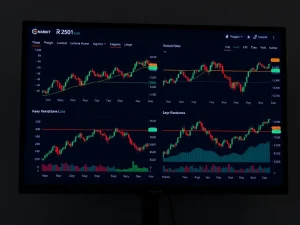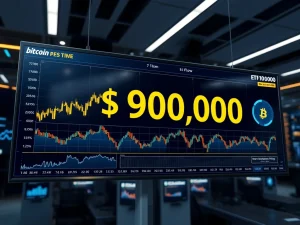Phenomenal Bitcoin ETFs: $10 Billion Volume Transforms Crypto Market Dynamics

The cryptocurrency landscape is undergoing a significant transformation. Specifically, US-based spot Bitcoin ETFs have emerged as a dominant force. These investment vehicles now contribute a substantial portion to daily spot trading volume, rivaling established crypto exchanges. This shift underscores a growing embrace of digital assets by traditional finance.
Bitcoin ETFs Drive Unprecedented Spot Trading Volume
US Bitcoin exchange-traded funds (ETFs) have quickly become a critical player. They now generate billions in daily trading activity. Blockchain analytics firm CryptoQuant highlights this remarkable growth. Julio Moreno, head of research at CryptoQuant, noted the ETFs’ pivotal role. He stated that these products offer significant investor exposure to Bitcoin.
On active days, US spot Bitcoin (BTC) ETFs consistently see volumes between $5 billion and $10 billion. This often surpasses the daily spot volumes of many major cryptocurrency exchanges. Such figures clearly reflect a robust and increasing institutional demand for Bitcoin. This demand is channeling traditional capital into the digital asset space.
CEX BTC volumes compared with spot BTC ETF volumes. Source: CryptoQuantComparing ETF Volumes with Centralized Exchanges
Despite the rapid rise of Bitcoin ETFs, centralized exchanges (CEXs) still hold a substantial share of the market. Binance, for instance, remains the world’s largest crypto exchange by spot trading volume. It consistently leads in overall trading activity. Bitcoin volumes on Binance have surged to $18 billion on peak days. Ether volumes have also reached highs of $11 billion.
However, the gap is narrowing for Bitcoin spot trading. According to CoinGlass, the total daily trading volume for the eleven US spot Bitcoin funds recently hit $2.77 billion. This figure represents approximately 67% of Binance’s daily spot Bitcoin volume, which stands around $4.1 billion, as reported by CoinGecko. While Binance’s total daily volume across all its pairs is much higher, around $22 billion, the concentration of Bitcoin spot trading in ETFs is noteworthy.
Nick Ruck, director at LVRG Research, emphasized the impact. He told Crypto News Insights that US spot Bitcoin ETFs are now a dominant force. They play a pivotal role in both price discovery and institutional adoption. This integration marks a new era for crypto market participation.
Institutional Demand and Market Reshaping
The emergence of Bitcoin ETFs signifies a maturing crypto market. Traditional investors now have regulated and accessible pathways to gain exposure to Bitcoin. This access fuels significant institutional demand. Consequently, it brings new capital and increased liquidity to the ecosystem. This influx helps stabilize prices and reduces volatility over time.
Moreno from CryptoQuant also observed trends in Ether (ETH) spot trading. He pointed out that ETH spot trading is primarily concentrated on Binance. Crypto.com follows as another significant platform. In contrast, ETFs rank sixth for ETH spot trading, accounting for just 4% of the volume. This indicates a slower initial ETF participation in ETH spot trading. It suggests a more gradual institutional adoption of Ethereum compared to Bitcoin.
Nevertheless, recent data tells a different story for Ether ETFs. This suggests that while adoption may have been slower, momentum is building rapidly.
The Rise of Ether ETFs: A New Wave of Crypto Market Liquidity
While Bitcoin ETFs have captured headlines, Ether ETFs are also making significant strides. Inflows into the eleven spot Bitcoin ETFs recently slowed. They totaled $571.6 million over a four-day trading period. BlackRock’s iShares Bitcoin Trust (IBIT) led these inflows, securing nearly 40% or $223.3 million. This period saw Bitcoin’s price slump by about 2.5%, falling to around $111,600.
Comparatively, spot Ether (ETH) ETFs have shown remarkable performance. They recorded an aggregate inflow of $1.24 billion over the same four trading days. This figure is more than double that of BTC funds. Ether funds have not experienced a net outflow day since August 20. They have also clocked over $4 billion in inflows this month alone. This accounts for 30% of their total inflow since their launch 13 months ago. This surge in Ether ETF inflows points to growing investor confidence and diversification within the institutional crypto space.
ETFs Reshaping Crypto Market Liquidity and Price Discovery
Current flow dynamics confirm that ETFs are not merely supplementing the market. They are actively reshaping crypto market liquidity. Their trading activity shows an increasing correlation with underlying BTC price movements. This suggests that ETF flows are now a key driver of market sentiment and price action. These products represent a significant percentage of Bitcoin’s total supply. Therefore, ETFs are cementing their role as a fundamental gateway for traditional capital. They bridge the gap between conventional finance and the digital asset world.
The impact of ETFs extends beyond mere volume. They also influence price discovery. As more institutional money flows through these regulated channels, their trading activity becomes a more reliable indicator of market sentiment. This contributes to more efficient and transparent price formation for Bitcoin and, increasingly, for Ethereum.
Key Takeaways for Investors and the Market
- Bitcoin ETFs are now a dominant force in spot trading, rivaling major exchanges.
- Growing institutional demand is driving significant capital into the crypto market.
- While Bitcoin ETFs lead, Ether ETFs are rapidly gaining traction with substantial inflows.
- ETFs are fundamentally reshaping crypto market liquidity and price discovery mechanisms.
- The integration of these products marks a critical step towards mainstream adoption of digital assets.
The ongoing evolution of the ETF landscape promises continued integration. It will further connect traditional finance with the innovative world of cryptocurrencies. This convergence creates a more robust and accessible market for all participants.









